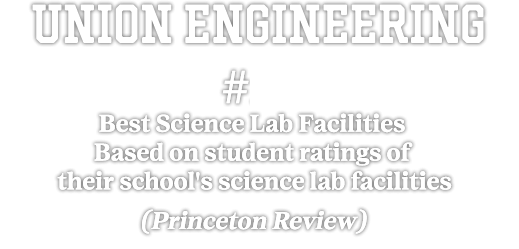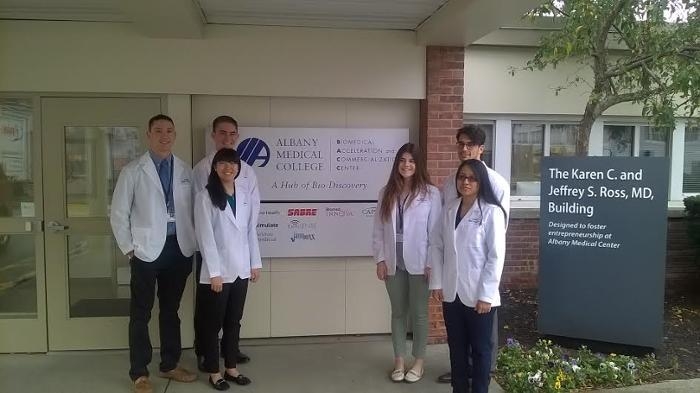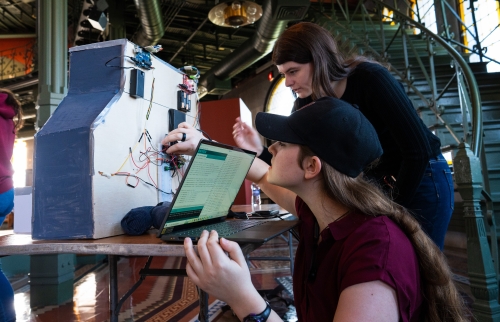



Six seniors were chosen to participate in a new immersion program in partnership with Albany Medical College.
The six are: Nicholas Williams, Matthew Drum, Lianna Gangi, Sonja Hansson, Luke McCaffrey and Yesenia Castelan
As a biomedical engineering major, Lianna Gangi ‘18 has a keen interest in how to apply engineering principles to find clinically viable and innovative solutions to medical problems.
But first, Gangi needed to get out of the classroom. The White Plains, N.Y., senior wanted hands-on training to interact with medical professionals and learn about the equipment and devices they use on a daily basis in providing patient treatment and care.
“What do they like about the devices? How could they be improved? What new devices could potentially be developed?” said Gangi. “I wanted to gain a better understanding of the environment in which the devices are used and observe the applications of the devices in real time.”
Through a unique new program, Gangi and five fellow biomedical engineering majors got the opportunity to explore firsthand the biomedical challenges facing health care providers and to develop possible solutions.
The seniors – Gangi, Sonja Hansson (Walpole, N.H.), Matthew Drum (Clifton Park,, N.Y.), Nicholas Williams (Milford, Conn.), Luke McCaffrey (Baldwinsville, N.Y.) and Yesenia Castelan (Bronx, N.Y.) were chosen to participate in the inaugural Union College Biomedical engineering Summer Clinical Immersion Program.
Through a partnership with Albany Medical College, the students spent six weeks last summer rotating through clinical areas, including cardiology, nephrology, pulmonary and critical care, gastroenterology, the OR and the emergency department.
“The goal of the program was to have our students identify problems or needs in the hospital that they could then design a solution for during the capstone design courses in the winter and spring terms,” said Jennifer Currey, associate professor of biomedical engineering and director of the biomedical engineering program.
Also assisting with the new program at Albany Med was Shane Cotter, associate professor of electrical, computer and biomedical engineering, and Sudhir Khetan, assistant professor of biomedical engineering.
Students spent the first week at the medical college’s Biomedical Accelerator and Commercialization Center, learning how to navigate the hospital setting and communicate with physicians.
The next four weeks were spent shadowing doctors and medical residents at Albany Medical Center. Students were able to witness procedures such as a kidney transplant, spinal surgery, hip replacement surgery and a hysterectomy.
They also observed office procedures, including cardiac ablation, colonoscopies and endoscopies.
“Being completely immersed in a hospital environment as engineers allowed us to develop and apply our engineering skills and at the same time broadened our understanding of medicine as a whole,” Drum said.
Hansson appreciated the opportunity to connect liberal arts engineers and health care practitioners in a demanding environment.
“Rotating between more than half a dozen departments, each day was a new experience which facilitated both observation of live procedures and professional conversations about possible improvements,” said Hansson. She has minors in electrical engineering, chemistry and studio arts. “Each of us was able to mold and convert those impactful moments into practical ideas for medical device development.”
Williams said a key benefit of the program was learning how to deal with failure.
“Doctors are trained to perform certain tasks in a way that minimize the potential harm to a patient, and they become so familiar with these methods that they have trouble imagining alternate ways to do the same thing,” he said. “That is where undergraduate students with minimal medical backgrounds can help, because our unbiased minds are not afraid of the consequences of failure in the same way that a doctor's is.”
For the final week, students shared their ideas with medical center physicians and staff from the Biomedical Accelerator. Of the 250-plus projects considered, the students chose 12 projects with the most patent and commercial potential that will form the basis of the senior capstone design course. Among the projects being considered are valve stenosis treatment, polyp fishing and a rolling walker for oxygen monitoring.
“The exposure to so many different areas of medicine helped me decide what direction I would like my career to take,” said McCaffrey, who has a minor in electrical engineering. “I wish every biomedical engineering student could have this experience.”
The biomedical engineering program at Union is relatively new, enrolling its first students in 2009, and it has quickly grown in popularity.That first year had nine majors, there are currently nearly 80 majors enrolled in the program. Currey, Cotter and Khetan are seeking support to continue the partnership with Albany Med.
“Our students come out of this program with experiences that will set them apart from other biomedical engineering, mechanical engineering and electrical engineering majors as they enter the job market,” she said. “They have been in the clinic, know how to speak with doctors, and can find problems that they can address as engineers. This is a skillset that cannot be easily replicated in a classroom.”

Ashok Ramasubramanian, Dean of Engineering and Co-Director of the Templeton Institute